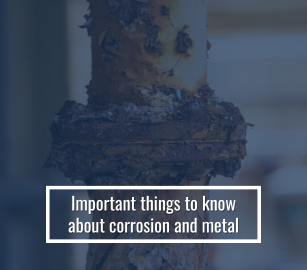
Important Things to Know About Corrosion And Metal

CORROSION: WHAT IS IT?
The breakdown of a metal due to chemical reactions with its surroundings is called corrosion. The kind and speed of deterioration are determined by the kind of metal and the surrounding environment, especially the gases that come into contact with the metal.
Corrosion is a hazardous and costly issue. It can cause restrooms to flood, oil pipelines to burst, chemical facilities to leak, and buildings and bridges to collapse. Air pollution has caused corrosion damage to artwork worldwide, corroded medical implants may cause blood poisoning, and corroded electrical circuits can result in fires and other issues. The safe disposal of radioactive waste, which needs to be kept in containers for tens of thousands of years, is threatened by corrosion.
DOES EVERY METAL CORRODE?
Any type of metal can rust. Some rust quickly, like pure iron. Stainless steel, on the other hand, is more commonly used since it mixes iron and other alloys and erodes more slowly.
Noble metals are a select group of significantly less reactive than other metals. They rust less frequently as a result. In actuality, these are the only pure metals that exist in nature. Unsurprisingly, noble metals are frequently highly precious. Gold, silver, platinum, palladium, and rhodium are among them.
CATEGORIES OF CORROSION
Metal corrosion can occur for numerous reasons. By mixing alloys with pure metal, some can be prevented. By carefully combining metals or controlling the metal's surroundings, others can be avoided. Below is a description of a few of the most prevalent forms of corrosion.
- CORROSION FROM GENERAL ATTACK - This frequent type of corrosion targets a metal structure's whole surface. Chemical or electrochemical reactions are the cause of it. A metal may fail due to general attack corrosion, although this is a recognized and expected problem. Thus, general attack corrosion can be anticipated and controlled.
- LOCALISED DETERIORATION - A metal structure is only partially attacked by this corrosion. Three categories of localized corrosion exist:
- PITTING - the formation of tiny holes in a metal's surface.
- CREVICE CORROSION - corrosion that develops in places with stagnation, like beneath gaskets.
- FILIFORM CORROSION - corrosion happens when water seeps through a paint or other finish.
- GALVANIC CORROSION - This can happen when two distinct metals are present in the same liquid electrolyte, such as salt water. To put it simply, corrosion occurs in only one of the two metals because the molecules of one metal are attracted to those of the other.
- ENVIRONMENTAL CRACKING - Some metals can fatigue, shatter, or become brittle and weak under harsh environmental circumstances.
Electrochemical processes cause the most prevalent types of corrosion. When most or all of the atoms on a single metal surface oxidize, the entire surface becomes damaged, referred to as general corrosion. Most metals are readily oxidized, meaning they frequently lose electrons to oxygen and other chemicals in the air or water. Oxygen and metal combine to produce an oxide when oxygen is reduced (gains electrons).
Galvanic corrosion is the process that occurs when different types of metal come into contact with one another and undergo reduction and oxidation. Water or other moisture gets trapped between two electrical contacts with an electrical voltage in electrolytic corrosion, primarily affecting electronic equipment. An unexpected electrolytic cell is the end outcome.
Consider a metal building like the Statue of Liberty. It appears robust and long-lasting. But like almost everything made of metal, it can break down and become unstable when interacting with other materials. Occasionally, corrosion is benign or advantageous: the statue's greenish patina shields the metal underneath from weather damage. But over time, rust seriously damaged the statue's interior. By 1986, the statue had reached its centenary, with nearly half of its iron frame rusting away due to its copper skin acting as an electrode like a giant galvanic cell.
PREVENTION OF CORROSION
Certain metals develop inherent passiveness or corrosion resistance. This happens when the metal corrodes or reacts with airborne oxygen. The end product is a thin oxide layer that prevents the metal from reacting further. Examples are the patina that develops on copper and the deterioration of some sculpting materials. Protection is compromised if the thin film is harmed or destroyed by structural stress, such as on a bridge or by scraping or scratching. In certain circumstances, the material may re-passivate; if not, the object corrodes only in sections. Since the damage is concentrated at these locations, it is frequently worse.
Another process to prevent corrosion is done with metal finishing. It is the process of changing the surface of a metal. Find out the importance of metal finishing to prevent rust and extend the lifespan of your metal.
Numerous strategies exist for preventing harmful rusting. Passive films on typically non-passive metals can be created by electrical currents. Certain metals exhibit more stability in specific situations than others, leading scientists to create alloys like stainless steel to enhance performance in these conditions. By using lasers, certain metals can be given a non-crystalline structure that makes them resistant to corrosion. The highly reactive zinc is applied to iron or steel during galvanization, creating a galvanic cell where the zinc corrodes instead of the iron. An inert or passivated metal is electroplated to protect other metals. Paints, oils, and plastics are non-metallic coatings that can stop corrosion.



































































